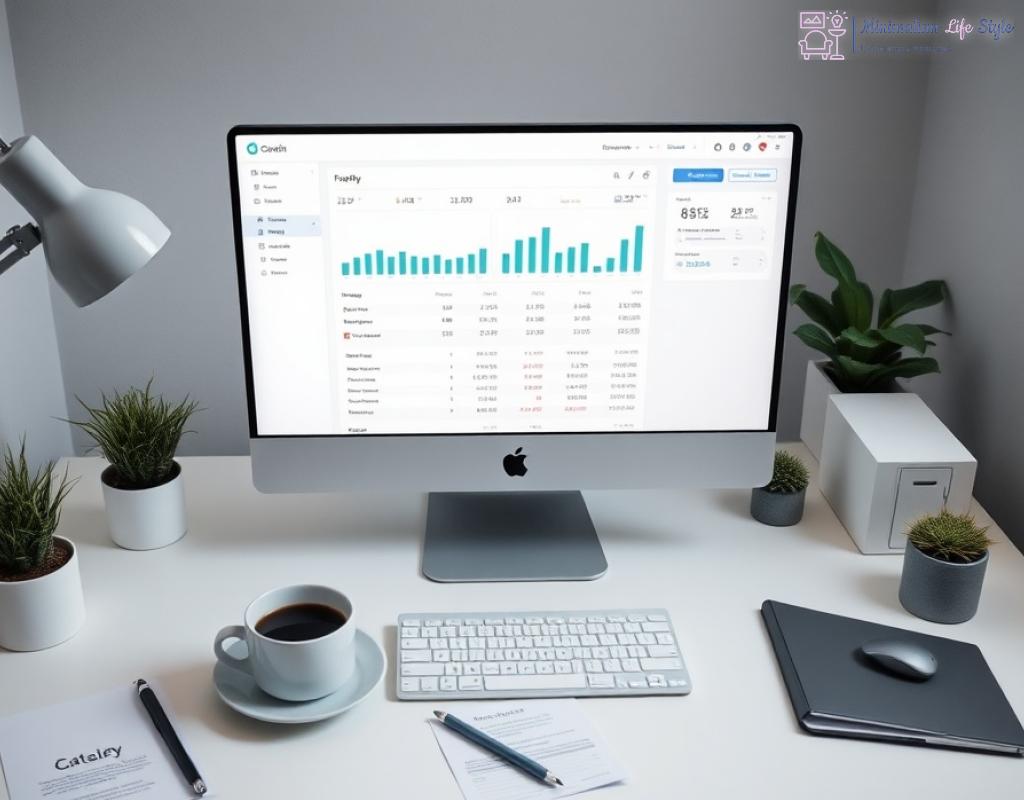Streamlining Your Budget: Go Digital

In today’s fast-paced world, managing your finances shouldn’t feel like a daunting task. The days of sifting through piles of receipts and maintaining handwritten ledgers are behind us. With technology at our fingertips, streamlining your budget has never been easier. Going digital not only enhances your efficiency but also empowers you to take control of your financial future.
With numerous budgeting tools available, choosing the right one can feel overwhelming. However, the benefits of employing digital solutions far outweigh the initial learning curve. From mobile apps to web-based platforms, these tools provide user-friendly interfaces that allow you to track spending, set financial goals, and receive real-time updates about your budget.
Here’s a comparison of some popular budgeting tools:
| Budgeting Tool | Platform | Key Features |
|---|---|---|
| Mint | Web, iOS, Android | Automatic transaction tracking, customizable budgets, credit score monitoring |
| YNAB (You Need A Budget) | Web, iOS, Android | Goal setting, proactive budgeting, educational resources |
| EveryDollar | Web, iOS, Android | Zero-based budgeting, easy expense tracking, flexible spending plans |
Ready to make the shift? Here’s a simple roadmap to help you transition to a digital budgeting system:
- Assess Your Current Budgeting Method: Take note of your current practices and identify areas that can be improved.
- Choose the Right Tool: Consider your financial goals and select a budgeting app that meets your needs.
- Input Your Financial Data: Gather your income, expenses, and any debts, and enter them into the app.
- Set Up Alerts: Enable notifications for bills and budget limits to stay informed.
- Review Regularly: Schedule weekly or monthly check-ins to adjust your budget as necessary.
By following these steps, you’ll be well on your way to achieving a streamlined and efficient budgeting process that works for you.
Mastering Online Banking: A Quick Guide
In the modern age, where convenience is key, online banking has emerged as a cornerstone of financial management. Gone are the days of waiting in long lines at the bank or dealing with cumbersome paperwork. With a few clicks, you can manage your finances anytime and anywhere. This guide aims to navigate you through the essentials of online banking, ensuring that you harness its full potential for maximum efficiency.
Understanding the features available in various online banking platforms can greatly enhance your banking experience. Here’s a comprehensive overview of what to look for when selecting an online banking service:
| Bank/Platform | Key Features | Pros | Cons |
|---|---|---|---|
| Chime | No monthly fees, automatic savings features | User-friendly app, early direct deposit | Limited ATM access |
| Ally Bank | High interest rates, no fees | Excellent customer service, easy-to-use interface | No physical branches |
| Capital One 360 | Comprehensive mobile banking options | Robust security features, flexible accounts | Higher fees on some accounts |
Transitioning to online banking can be straightforward if you follow these essential steps. By mastering online banking, you’ll not only simplify your financial life but also enhance your overall efficiency.
- Choose Your Bank Wisely: Research various banks and their online offerings. Look for features that align with your financial goals.
- Set Up Your Accounts: Open your accounts online, ensuring you provide accurate information to avoid any issues.
- Secure Your Account: Implement strong passwords and enable two-factor authentication for added security.
- Explore the Mobile App: Familiarize yourself with the app’s layout and features, such as bill pay and fund transfers.
- Track Your Transactions: Regularly review your transactions to maintain oversight and quickly address any discrepancies.
By embracing online banking and following these steps, you can minimize paperwork while maximizing efficiency, allowing you to focus more on what truly matters in your financial life.
Tax Time Made Easy: Digital Tools for Filing
As the tax season approaches, the thought of gathering documents and filling out forms can send shivers down anyone’s spine. However, the digital age brings with it a plethora of tools designed to take the sting out of tax time. By leveraging these technologies, you can turn what was once a cumbersome task into a streamlined process that saves you time and reduces stress.
The right digital tools can simplify your tax preparation and ensure that you’re maximizing your deductions while minimizing potential errors. With software designed to guide you through every step of the filing process, you can feel confident that your taxes are in good hands. From tracking expenses to securing your sensitive information, these platforms offer solutions tailored to a range of needs. Here’s a look at some of the leading digital tools for tax filing:
- TurboTax: Comprehensive tax filing software that offers personalized guidance based on your unique financial situation. With features like import of W-2s and extensive deduction tracking, TurboTax makes filing straightforward.
- H&R Block: Known for its user-friendly interface, H&R Block provides a robust online platform along with the option for in-person consultations with tax professionals if needed.
- TaxAct: A budget-friendly option that doesn’t skimp on features, TaxAct allows you to file simple returns for free while offering affordable packages for more complex tax situations.
To make the most of digital tax filing tools, follow these steps to ensure a smooth experience:
- Gather Your Documents: Collect all necessary documents including W-2s, 1099s, and receipts for deductible expenses.
- Choose Your Software: Based on your needs and budget, select the digital tool that best suits your filing requirements.
- Create an Account: Set up your account with the chosen software, ensuring that you provide accurate information to avoid any mishaps.
- Input Your Information: Enter your income and expenses into the software, taking advantage of any automated features that can import data directly.
- Review and File: Carefully review your return for accuracy before submitting. Most tools will offer a final check to help identify potential errors.
When it comes to your financial information, security is paramount. Most reputable tax filing software implements robust security measures such as encryption and two-factor authentication to protect your data. Always ensure that you are using a secure internet connection and consider using a virtual private network (VPN) when accessing sensitive information. With these precautions in place, you can file your taxes with peace of mind, knowing that your financial information is safe from prying eyes.
Effortless Expense Tracking: Apps That Work
In our increasingly digital world, managing expenses no longer requires tedious spreadsheets or crumpled receipts. Innovative apps are revolutionizing the way we track our spending, making it not only straightforward but also engaging. With the right tools, you can gain valuable insights into your financial habits, allowing you to make informed decisions with ease. Here’s a closer look at some of the leading expense tracking applications that promise to enhance your financial management experience.
Choosing the right expense tracking app is crucial for achieving financial clarity. Each app comes with unique features designed to cater to different preferences and lifestyles. Below is a comparison of some popular expense tracking apps that stand out in the market:
| App Name | Platform | Key Features | Pros | Cons |
|---|---|---|---|---|
| Expensify | Web, iOS, Android | Expense reporting, receipt scanning | Excellent for business expenses, real-time tracking | Can be overwhelming for personal use |
| Spendee | Web, iOS, Android | Shared wallets, budget planning | Visual spending insights, easy to use | Limited features in free version |
| Wally | iOS, Android | Personal finance management, photo receipts | Intuitive interface, strong community support | Currency support can be limited |
To maximize the benefits of these expense tracking apps, follow these straightforward steps that will help you get started:
- Identify Your Needs: Consider what features are most important to you, such as budget planning, receipt scanning, or shared accounts.
- Download and Set Up: Choose an app that resonates with your needs and install it on your devices. Follow the setup instructions to link your bank accounts or input your expenses manually.
- Track Daily Expenses: Make it a habit to log your expenses daily or utilize features that automatically import transactions from your bank.
- Review Regularly: Set aside time weekly or monthly to review your spending habits and adjust your budget accordingly. Many apps provide insightful reports that can help you pinpoint areas for improvement.
- Stay Consistent: Consistency is key in expense tracking. The more regularly you input your data, the clearer your financial picture will be.
By leveraging these apps and following the steps outlined, you can transform the way you manage your finances, reducing stress and boosting efficiency. Embrace the digital tools available, and you’ll find that tracking your expenses is not only manageable but also empowering.
Secure Your Financial Future: Digital Document Management
In the realm of personal finance, organization is key to ensuring that your financial future remains secure. Traditional methods of managing important financial documents can be cumbersome and prone to errors. Fortunately, with the advent of digital document management systems, you can now store, organize, and access your documents efficiently, all while minimizing the amount of physical paperwork you handle. Imagine having everything you need at your fingertips, accessible from anywhere and at any time. This shift not only enhances productivity but also provides peace of mind knowing that your crucial information is safeguarded.
When selecting a digital document management solution, it’s essential to understand the features that can significantly enhance your financial management experience. Look for systems that offer cloud storage, allowing you to back up your documents securely and access them from multiple devices. Additionally, features such as document sharing capabilities enable you to collaborate with financial advisors or family members effortlessly. Another vital aspect is the search functionality, which allows you to find specific documents quickly, saving you time and frustration. Many systems also provide robust security measures to protect sensitive information, ensuring that your financial data remains confidential.
Transitioning to a digital document management system can be a game-changer for your financial organization. Start by assessing your current document management practices and identify which documents are essential for your financial planning. Once you’ve pinpointed these documents, choose a digital platform that meets your specific needs, taking into account features such as ease of use and storage options. After selecting a platform, begin the process of scanning and uploading your documents. Organize them into easily navigable folders, and tag them appropriately to enhance searchability. Finally, establish a routine to regularly backup your documents and ensure that your digital repository remains up-to-date. By following these steps, you can transition smoothly into a more efficient way of managing your financial documents, ultimately securing your financial future.




